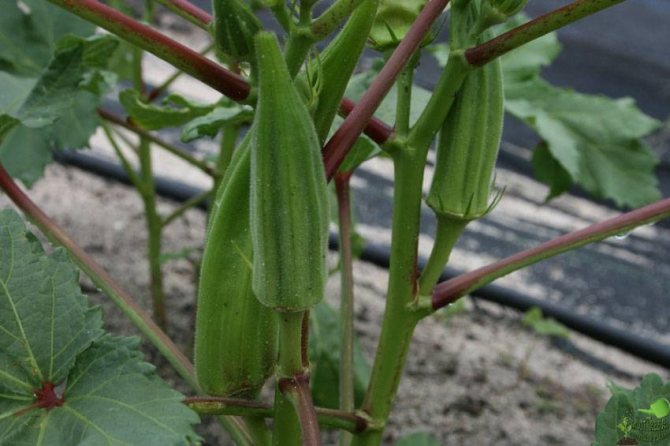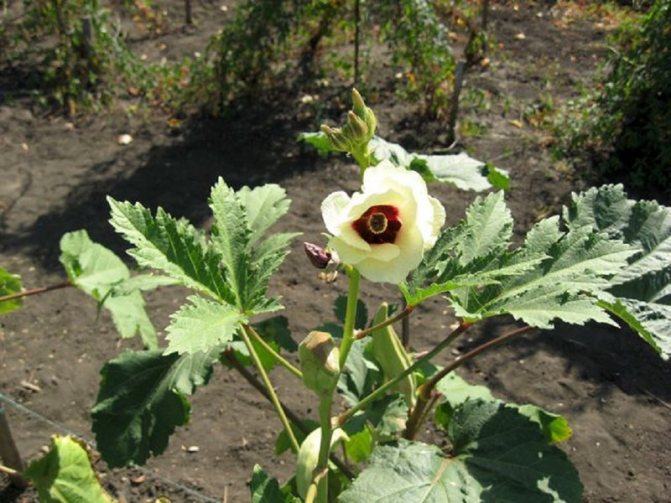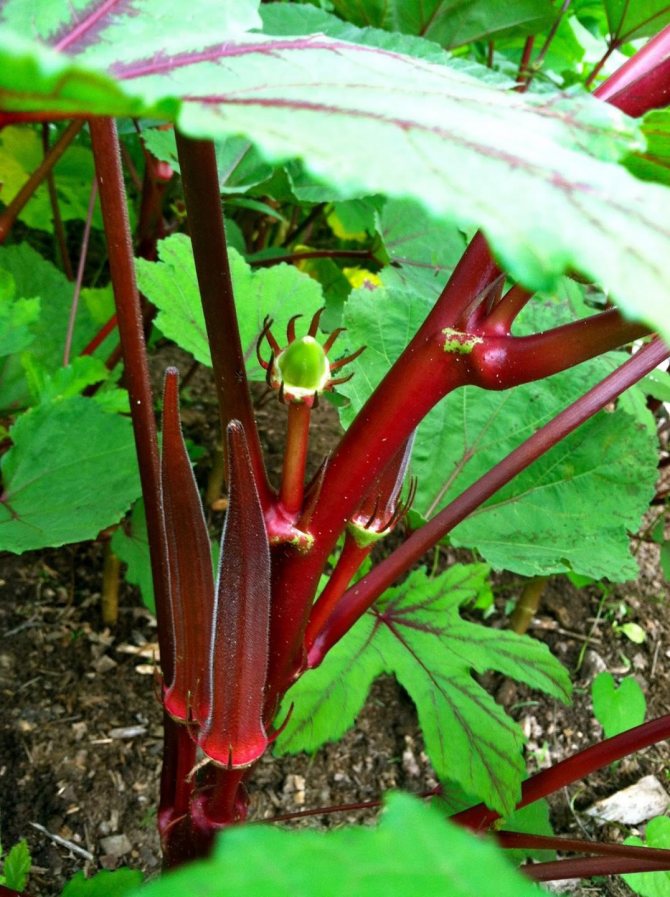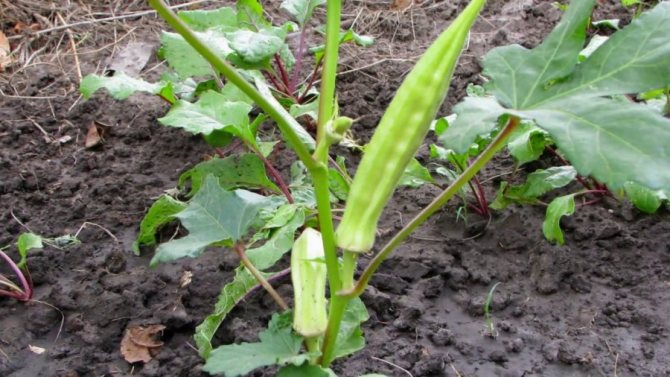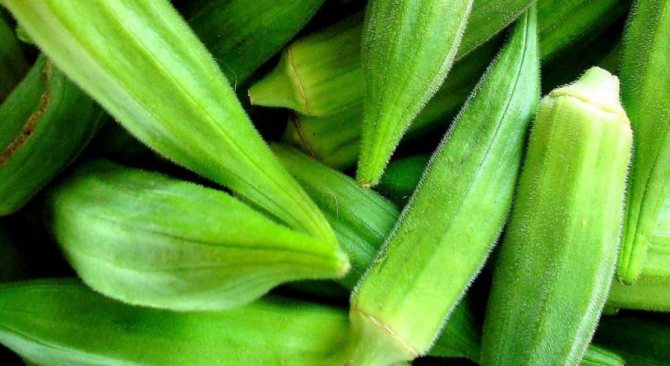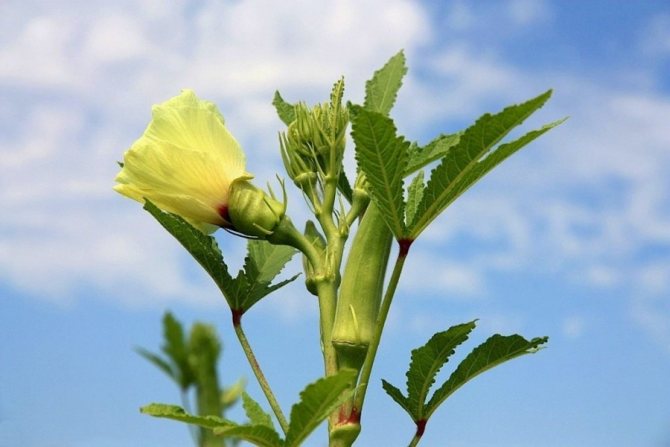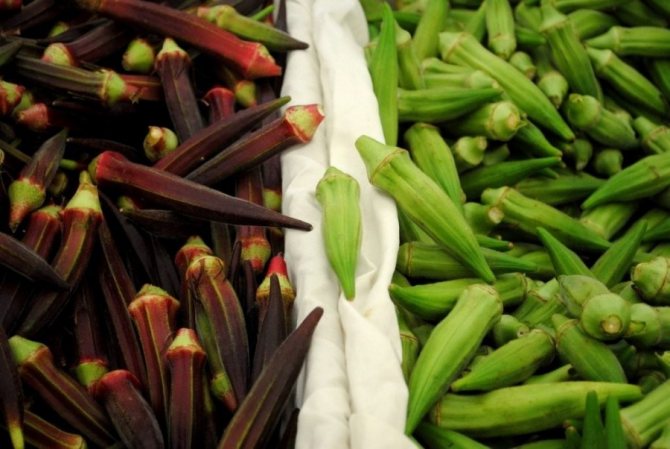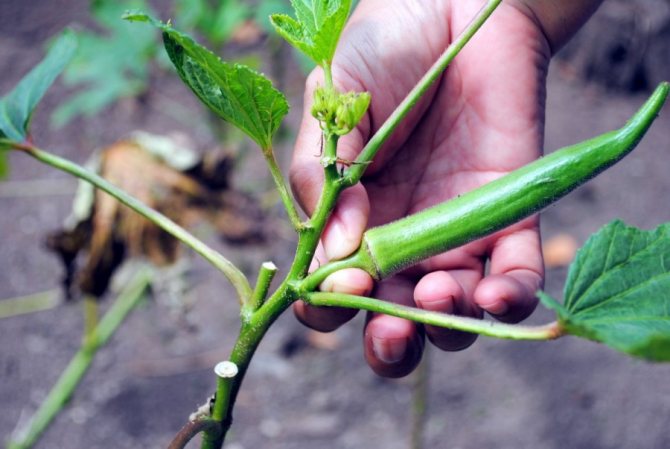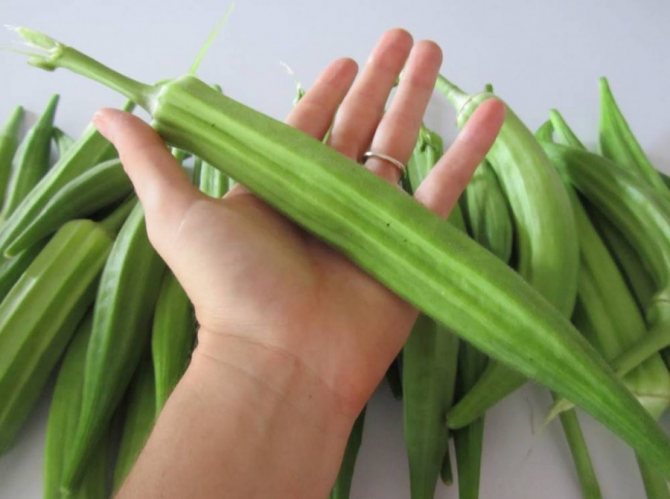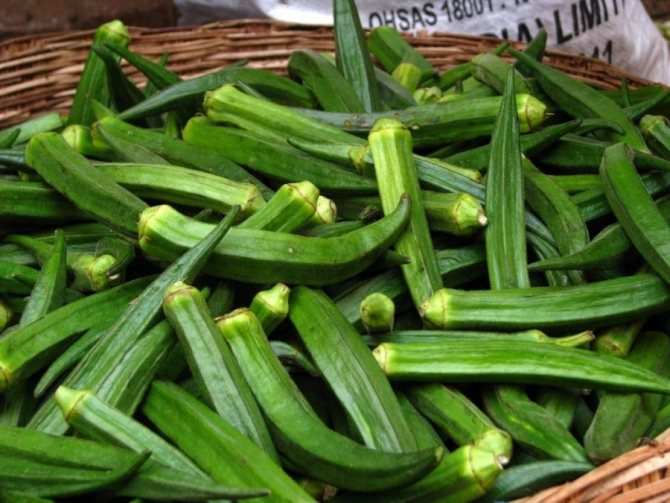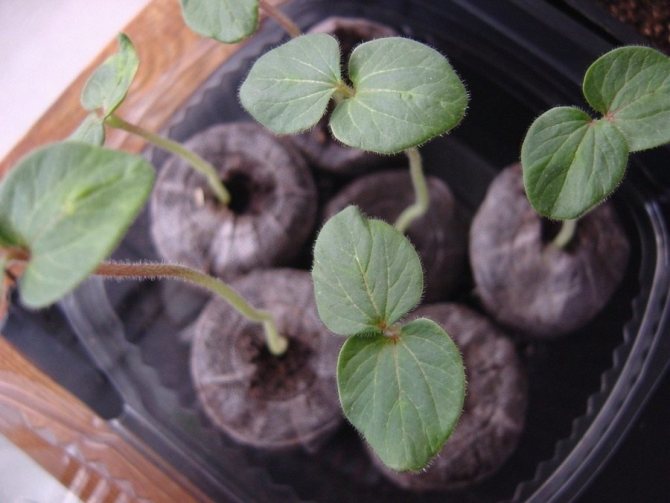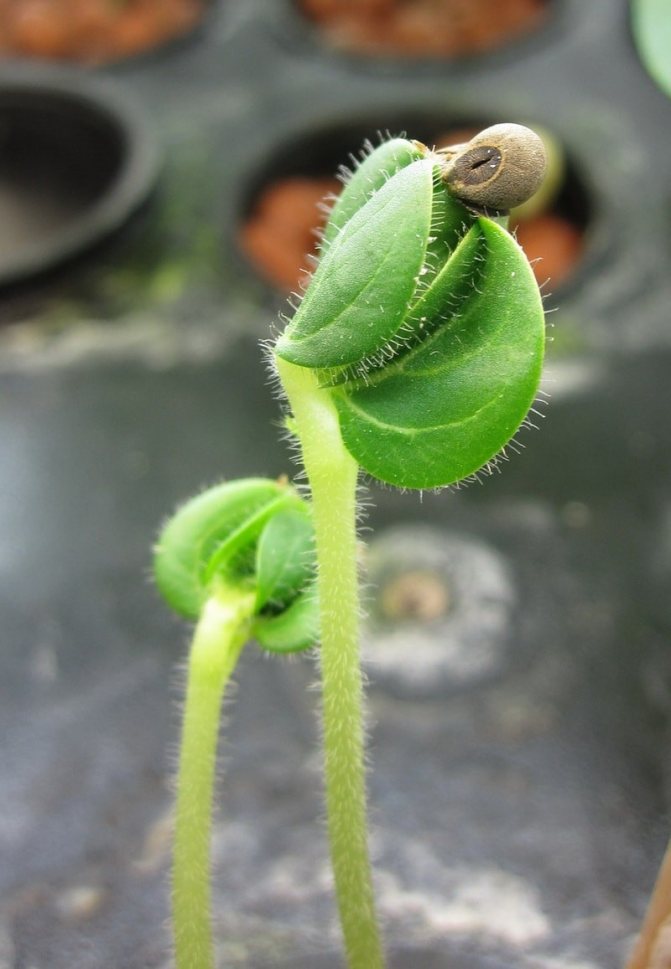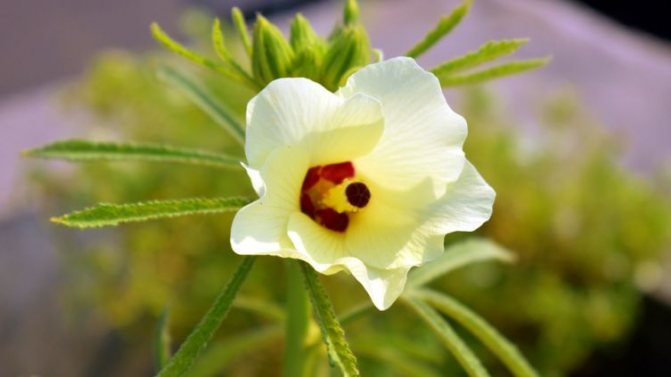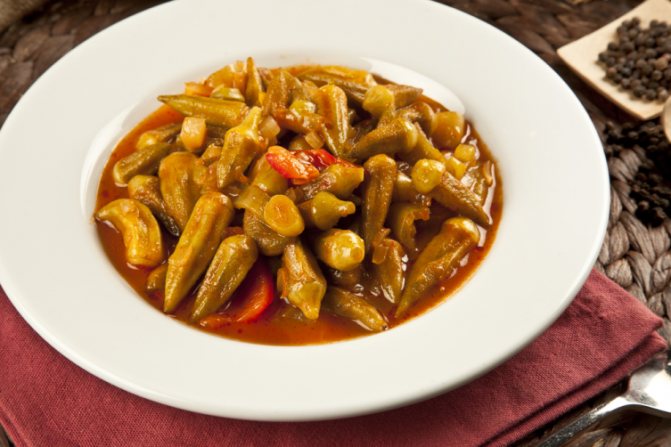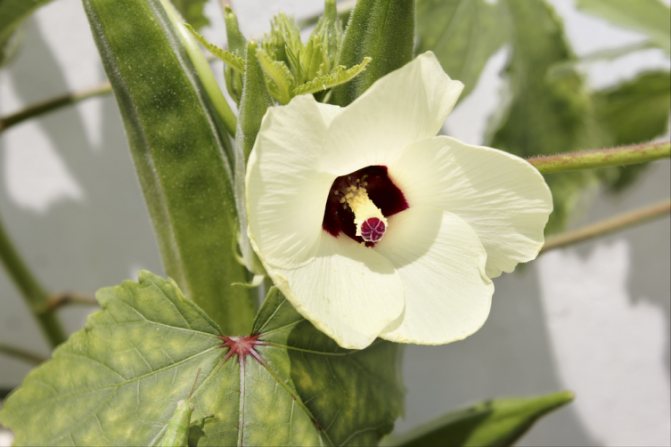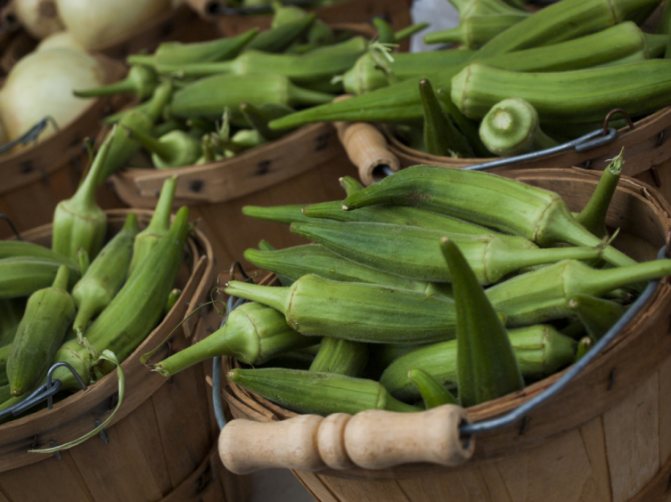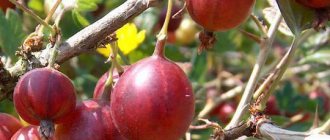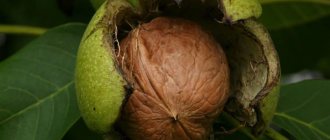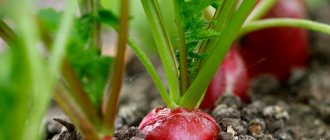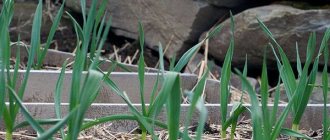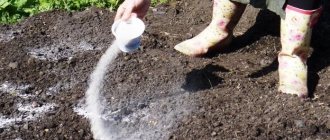Okra was born in Africa. The first memories of her date back to the 11th century. This plant was discovered by the Egyptians, they used this relative of mallow for the manufacture of fabrics and glue. Okra has a lot of names. She can be called Okra, Gombo or Okra ladies' fingers. There are several varieties of this exotic plant: Bombay okra, Juno okra, etc.
So what is okra and how is it grown? A high yield of this vegetable crop can only be obtained by planting it in well-fertilized soil. Therefore, it is good to plant okra in the place on the site where the cucumber previously grew, because he also loves mineral and organic fertilizers. You need to plant in a place well-lit by the sun. Planting in clay or cold soil will cause the okra to die. It is best to plant in a place protected from the winds. Since okra loves warmth, it is planted in the southern regions of Russia. It is recommended to plant the plant in the soil in the last decade of April, when the frosts are already over, but it is still covered with agrofibre. The lowest temperature that Ladies' fingers can withstand is -2. But in the northern regions of Russia, you can also grow this crop. To do this, you need to remember a few basic rules for her care.
In the northern part of Russia, in cities such as Siberia or the Urals, where the temperature is low for most of the year, it is recommended to plant okra in open ground, like eggplant, only after growing seedlings. In the 19th century A.P. Chekhov was engaged in the cultivation of okra in the Moscow region. Okra grows like a liana.
What does an okra plant look like?
Okra - what is it? There is nothing unusual in the appearance of this plant. It can reach a height of two meters. Although there are dwarf varieties that grow no more than 50 centimeters. The size of the fruit also depends on the type of plant. It can reach a maximum of 25 centimeters, and the minimum is 10 centimeters.
The stem of the okra is very thick and at the base may have several branches (up to 7 stems). The leaves of the plant are large, colored in light or dark green. The flowers of the okra are large, yellowish cream. They are arranged in a single order. The most important advantage of this plant is its fruits.
To understand what this unusual vegetable is - okra, try to imagine a hybrid of zucchini, chili and bean pod. An annual plant, reaching a height of 40 cm to 2 meters (under favorable climatic conditions and correct cultivation), with a thick stem, on which there are many branches, with light green, wide, carved leaves.
The vegetable culture okra is an annual herb. She has a thick pubescent stem, branched at the base, long-petiolized large leaves, in the axils of which there are large creamy flowers. Fruits are multi-seeded capsules.
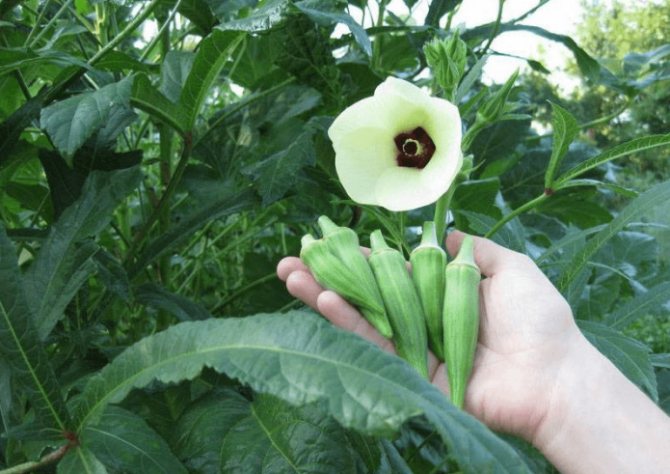
Okra flowers are quite decorative, but its main value is in the fruits.
All varieties bloom with rare single cream flowers, shaped like tulips, with a strong tart odor. The plant is quite decorative, but the main value is in the fruits. Okra fruits are shaped like green pepper pods. They are sometimes described as "a cross between bean pods and pepper."
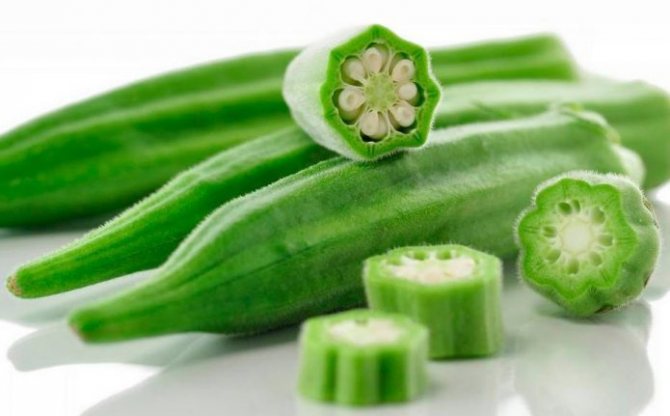

Okra fruit tastes like asparagus
The world is unanimous regarding the recognition of the benefits of this vegetable. Okra is recommended for medical nutrition with a huge list of diseases, because the main effect of its use is to increase the general tone of the body, strengthen immunity and supply the body with a complex of vitamins and minerals. The plant has a unique composition, which provides its benefits.
- Vitamins A, B6, C, K increase immunity, so okra recovers well in case of overwork and after illness.
- Minerals magnesium, iron, calcium, potassium, sodium, zinc, phosphorus are involved in the processes of blood circulation, strengthening blood vessels and normalizing blood pressure.
- Due to the large amount of fiber, normal bowel function is maintained.
- Vegetable proteins give a feeling of fullness with a minimum calorie content, and this normalizes weight.
- Mucous substances normalize sugar levels in diabetes, have an anti-inflammatory effect on the gastrointestinal tract.
- Folic acid is beneficial for pregnant women for the proper development of the fetal neural tube.
- The antioxidant glutathione prevents the development of cancer.
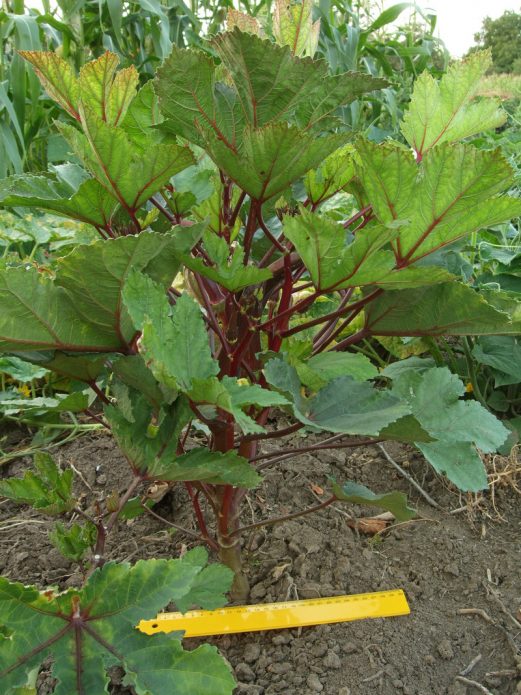

Okra is considered an aphrodisiac, although there is no serious scientific research on this topic.
Application in medicine


Due to its high taste and the many beneficial properties shown, the fruits of edible hibiscus are used in medical nutrition for various pathologies.
With pathologies of the respiratory system
Means made from okra (decoctions, infusions) effectively fight respiratory diseases:
- cough;
- sore throat;
- laryngitis;
- bronchitis;
- tracheitis;
- bronchial asthma.
Increasing the general and local immunity, the use of the fruits of this vegetable in food is useful for various infectious pathologies.
For diseases of the digestive system
Okra dishes are recommended for regular use with:
- gastritis;
- gastric ulcer and 12 duodenal ulcer;
- enterocolitis;
- acute and chronic hepatitis;
- cirrhosis;
- hepatic degenerations (fibrosis, fatty hepatosis);
- dyskinesia of the biliary tract;
- pancreatitis;
- dysbiosis;
- constipation;
- hemorrhoids and fissures of the rectum.
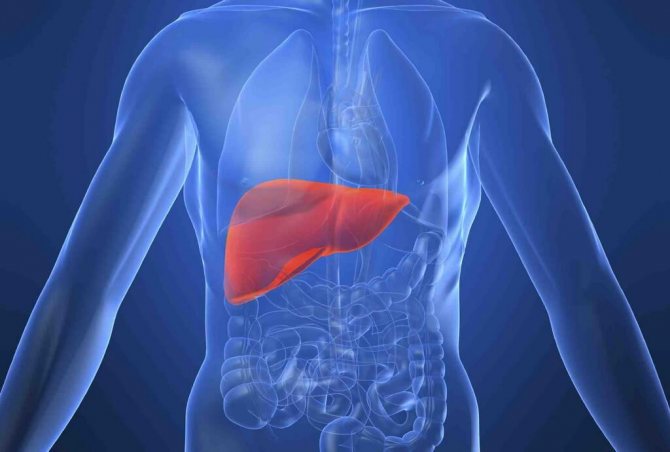

Okra restores damaged liver cells, showing a hepatoprotective effect. The fruits of this vegetable improve the condition of the liver after courses of chemotherapy, antibiotics, and severe infectious diseases.
Eating okra in its raw form or in dishes made from it is also useful for diseases of the heart and blood vessels, disorders of microcirculation in the brain, diabetes mellitus and diabetic microangiopathies.
The antioxidant properties of glutathione contained in edible hibiscus are successfully used in complex treatment:
- autoimmune diseases;
- diabetes mellitus;
- autism;
- Parkinson's and Alzheimer's disease;
- chronic fatigue syndrome;
- cataracts.
Edible hibiscus is indicated for men with problems with potency of various origins, prostatitis, after suffering venereal diseases.
Description
Okra is an annual herb that can grow up to 40 cm in height. However, there were also cases when a vegetable could reach a height of 2 meters. The okra has a very thick, branched stem, and the leaves are slightly pulled down and have a light green color. The leaves are either five-lobed or seven-lobed.
Many people compare okra to eggplant. This plant really needs a similar care. Okra is demanding for heat, which is why it has gained great popularity in the southern regions. However, at present the situation has changed somewhat and now it can be grown in any country. Okra can be found fresh or frozen on store shelves. The fruit is also found in the markets. Harvesting is most often done between August and November.
Conditions for growing okra
In the process of choosing okra, sufficient attention should be paid to its appearance. The plant pods should be long. They can be bright green without damage, mildew, or dry areas. It is worth giving preference to young and delicate fruits, pleasant to the touch. In some cases, there are also those that have a dark or reddish color.
Since gombo is perishable, it can only be stored for about three days. If you decide to keep the vegetable in the refrigerator, you should wrap it in a newspaper or bag.
Okra grows without much trickery and complexity. She loves moisture, sun and fertile loose soil.
The advice of experienced experts on how to grow okra is simple, since the plant does not require serious effort. There are a few simple steps you can take to help you grow a good crop:
- Fertilize the soil well before planting; in this case, additional feeding is not required. In case of poor development of plants, you can water them with diluted water, complex, mineral fertilizer.
- It is impossible to overmoisten the soil, especially in the period preceding fruiting.
- For active stimulation of tillering, pinch the main stems at a distance of 50, 60 cm from the ground.
- Provide support for a tall variety.
- Huddle the stems at the base in time, loosening the ground.
- When growing okra in a greenhouse or under a plastic sheeting, provide the plants with frequent ventilation.
All these simple manipulations constitute the main complex of agrotechnical methods for growing okra, their observance will provide the plant with a comfortable development and a bountiful harvest. Do not plant okra in swampy areas or places where groundwater is close to the surface; choose places with a light soil composition that promotes high fertility.
How does okra grow?
This culture is growing rapidly. Okra is thermophilic, which makes it close to eggplant. The optimal temperature that allows the plant to develop normally is 23-26 ° C, when the temperature drops to -16 ° C, okra stops growing and developing, and when it freezes, it dies. Gardeners, sharing their experience on how to grow okra in the country, recommend planting it with seedlings.
Prepare the soil in the fall, dig up and fertilize it with organic, phosphorus and potassium compounds, humus. Dig again in the spring with the introduction of ammonium nitrate. Chernozem is best suited for this vegetable crop; in areas where it is not, use a greenhouse or a film shelter, it is believed that okra grows on most soils, except for clay, saline or excessively wet.
The okra vegetable plant does not need frequent watering, it should be done once every five days, provided there is no rain. This watering regime is maintained until the time of fruiting, after the first pods have set on the stems, you need to water the plant twice a month. Water in moderation, do not overdo it, so that the delicate roots of the okra do not begin to rot.
Top dressing when growing okra is made in the case of slow growth, poor soil fertility two to three times, in the period preceding the onset of the ovary appearance. A complex of mineral fertilizers is used for this, the doses are taken to be minimal. With the onset of the fruiting period, feeding is done once, for this, potassium nitrate is used.
The flowering period of the okra begins in July, the flower is large, yellowish-creamy, located in the leaf axil, where the fruit is formed in the future, blooming bright okras look spectacular. The first fertilizing from mineral elements must be applied after the buds appear, provided that the soil is conscientiously prepared for planting seedlings or seeds.
Okra - care
According to vegetable growers, planting and caring for okra is a simple process, but the fruits of this plant have completely unique qualities.Heat-loving, southern plant, with good, proper care, grows well and gives a bountiful harvest, far from in southern conditions. Planting is best done with seedlings, because the seeds have a long germination period (from 3 to 4 weeks), and require warm, well-moistened soil.
Regular care of the plant, constant weeding, avoiding hardening of the soil around the okra, are necessary in the first month, in the future, such careful care is no longer necessary. Watering the okra should be done in case of severe drought, if the soil is dry, soaking the soil to a depth of 40 cm. Weed and loosen the soil in time, feed and water - this is the minimum set of activities that okra needs.
It should be noted that growing okra is not an easy task. This is due to the climatic characteristics of some regions. Okra is a thermophilic and light-loving plant. Therefore, it will not work to grow it in Central Russia in the open field. But the cultivation of okra is possible in a room environment. In such conditions, it develops well and gives rich yields.
It is better to use peat pots for germination. Okra loves light and fertile soil. It is also recommended to use a large amount of organic fertilizers. If the climate permits, then the seedlings are subsequently planted in open ground or in a greenhouse.
Okra, whose seeds germinate very slowly, requires a lot of heat. Therefore, it is necessary to create all the necessary conditions for it. To speed up the emergence of seedlings, you need to soak the seeds in warm water for a day before planting. We use peat pots for seedlings. The soil can be taken ready-made or garden soil.
An important point is the presence of a large amount of organic and mineral fertilizers. Seeds begin to germinate at a minimum temperature of 18 degrees. Three or four seeds are placed in each pot. Planting depth should be no more than 3 centimeters. The first shoots will appear in two weeks. Thinning seedlings is a must.
In the future, good okra will grow from it. Growing from seeds does not require any particular effort. The main thing is warmth (20-22 degrees). Naturally, the plant needs watering as the soil dries. But you should not overdo it with this. Okra does not like excessive moisture. It is a drought tolerant plant. It will be useful to feed the seedlings with phosphorus fertilizers.
The benefits of okra
This vegetable can be called very healing. First, fiber, which is available in large quantities, improves digestion. Eating okra helps to remove cholesterol and toxins from the body. The work of the heart is normalized. This plant helps to get rid of lung diseases, flu symptoms, bronchitis and sore throat.
With all this, okra contains only 30 calories for every 100 grams of product. Therefore, it is successfully used in diets. Recent studies have shown that the plant works against the formation of certain types of malignant tumors. Eating okra reduces the risk of developing atherosclerosis.
Diseases and pests
With proper care of okra, there should be no problems with it. But as soon as the rules of agricultural technology are violated, or the next dose of preventive measures is missed, then the disease and the pest are right there. As you know: "it is better to prevent than to cure later!"
The plant can get sick rust and powdery mildew... Of the pests that can affect the plant: whitefly, aphid, spider mite, slugs, scoops and moths.
In the fight against parasites, you should not use standard chemical agents, since in this case the okra fruits will become unsuitable for consumption. Therefore, spraying with infusions of garlic or tomato tops will help get rid of insects (it is infused for a day).Slugs are collected by hand, and those that are hiding will surely come out and fall into a trap if bowls of beer are placed under the plant.
In order to prevent fungal diseases, it is necessary to carry out preventive treatment with a strong solution of soda and soap (using a sponge, wipe the trunk and leaves).
Moreover, dark spots may appear on the leaves - these are sunburns, you can avoid them if you spray the bushes only on a cloudy day or in the evening.
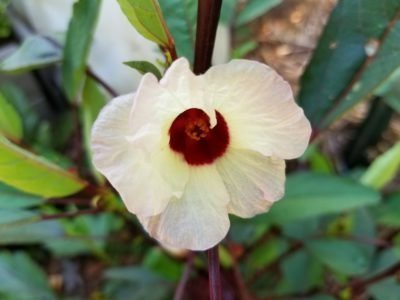

Planting and caring for okra
In advance, a month and a half, before planting okra in the ground, sow the seeds in prepared containers with soil. It is most rational to start preparation in the first or second decade of April. Plant the prepared (soaked for two hours) seeds in a prepared box (container), to a depth of 1.5 cm, put glass on top or stretch a transparent film.
For soil, take soil, peat and sand mixed in proportions 2: 2: 1, preheated in the oven. One of the best options is the one in which the cultivation of okra from seedling seeds is carried out in cups of peat, two or three pieces each (so that later one will leave one sprout, the strongest).
Before planting okra from seeds outdoors, soak the seeds for a couple of hours in lukewarm water or in a solution used to stimulate root growth. Planting should be done after the soil is thoroughly warmed up. Having made holes, the depth of which is not less than 3-4 cm, water them well and put 2-3 seeds in each, sprinkle with earth.
Planting dates for okra
Start growing okra from seeds at home 30-45 days before planting in open areas in the garden. In some regions, frosts really recede only by the 20th of May, in the more southern part, seedlings or seeds are planted after May 10. The required soil temperature at the depth required for planting is not lower than 14-15 ° C. Some experienced gardeners advise planting okra seedlings in early June, after the soil has completely warmed up.
If you are going to grow okra, you should be aware that the growing process will not be too easy, as this plant has its own characteristics. Okra seedlings are planted in early summer, when the soil is already warm enough.


Sowing seeds is best done in April. For planting planting material, you should pay attention to peat pots or disposable glasses. Such a container is perfect for okra roots, as they grow very long and it is important not to damage them during the transplanting process.
Okra may well do without feeding.
But it should be watered generously, trying to moisten the soil to a depth of 30–40 cm.
The stepchildren are removed, since they give a small crop, but at the same time they shade the main stem and make it difficult to care for the plants.
Important! The stem of the okra is pubescent, which can cause itching in some people. Therefore, they take care of the exotic in gloves and clothes with long sleeves.
After a month and a half, you can transplant the seedlings to a permanent place. In warm areas, it can be open ground. The main thing when planting is a small density. To get a good harvest, plants should be planted at a distance of 30-50 centimeters from each other.
There should be at least 60 centimeters between the rows. The landing is carried out in the first half of June. If okra is cultivated in a greenhouse, adequate ventilation must be provided. The plant does not like high humidity and strong overheating. Okra, growing from seeds of which is the most common method, develops well in indoor conditions. For planting, use a large container and place it on the south side.
Okra will delight with its fruits if all the conditions for its growth are met.Wherever this vegetable is cultivated, it needs warmth. But you should not allow overheating either. Watering is carried out as the soil dries. It is impossible to moisten the soil too much.
Okra loves light soils. Therefore, loosening the soil is vital for her. You also need to monitor the appearance of weeds and remove them in time. The plant also needs feeding. For this, organic fertilizers are used, which are best applied to the soil before planting. You can also use mineral products.
Planting seedlings in the beds
Okra seedlings are placed in open ground at the age of 40-45 days. By this time, they are stretched to a height of 10-15 cm. Usually, they are planted in early June, when the ground warms up well. They use a scheme for her, according to which plant seeds are sown in open ground. Seedling beds are prepared in advance, choosing weeds from the soil and abundantly fertilizing it with humus.
Planting okra is a responsible process. It is he, like competent care, that determines the successful cultivation of a crop. The planting of seedlings is completed by sequentially performing 3 procedures:
- abundant watering;
- mulching the soil surface;
- stretching the film to protect against cold and wind.
Okra develops well in greenhouse conditions. It needs to be watered less often, since water from the soil under the film evaporates more slowly. But if the greenhouse is not ventilated, the air in it becomes too humid, which can ruin the plants. Therefore, the film is regularly lifted. Caring for seedlings also involves controlling the temperature inside the greenhouse, it should be within the range of 20-30 ° C. Overheating will not benefit young people.
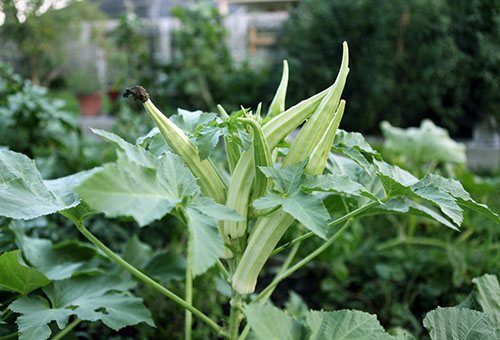

Okra in cooking
This plant is especially often used in cooking. Unopened fruits, which resemble green beans, are eaten. They usually ripen in 4-5 days. The fruiting period lasts all summer until late autumn. Young leaves of the okra plant are also eaten. Is this culinary exploration, a tribute to fashion, or is it perhaps something else?
This vegetable cooks very quickly. Its delicate fruits do not need to be subjected to prolonged heat treatment. Okra goes well with tomatoes, onions, ginger, garlic, pepper, various spices and lemon juice. Season the dishes, if possible, with butter. Lamb, fish and poultry dishes will be more expressive when this vegetable is added. The young leaves of the plant are used in fresh salads. Okra, the properties of which are known to many nations, is used in different cuisines of the world.
How to grow okra in our conditions
The tropical origin of this plant can force many gardeners in Ukraine, the Moscow region, central Russia, and even more so Siberia to abandon even attempts to grow this plant at home. But there is literary evidence that the writer A.P. Chekhov more than a century ago successfully cultivated okra in his Melikhovo near Moscow.
In order to grow okra with us, you need to understand well what this plant needs.
In the tropics, 1 sq. m, a huge amount of mass grows, which rotates on the spot for centuries, forming a very loose and fertile layer of soil of great thickness. This is the native soil for okra.
Our soils, even fertile loose chernozems, will require improvement with a large amount of loose humus. Or peat, but peat contains almost no nutrients, so it, in turn, must be corrected by adding a complex fertilizer according to one of the universal recipes:
- 30 g of nitrogen fertilizer, urea urea or ammonium nitrate, and 0.5 liters of wood ash per 10 liters of peat;
- 40 g complex fertilizer;
- 20 g of nitrogen fertilizer, 20 g of nitroammophoska.
It is important to know that the main thing for okra is warmth, not the quality of the soil. In a cold summer, it will not grow even on the best soil. And vice versa - in a warm summer it will grow even on imperfect soil.
Illumination
Okra does not have an extra demand for light.By definition, the tropics are thickening, shading and fighting for a place in the sun. But in our northern latitudes, it should grow exclusively in a sunny place no closer than 6 m from buildings and high thickets on the south side and no closer than 4 m from other sides, for fences and low shrubs these figures are 4 and 2 m, respectively.
Planting scheme for low-growing varieties - 30–40 cm between bushes, 60 cm between rows. For medium-sized people, these figures are 10 cm more, and for tall ones they are another 10 cm more.
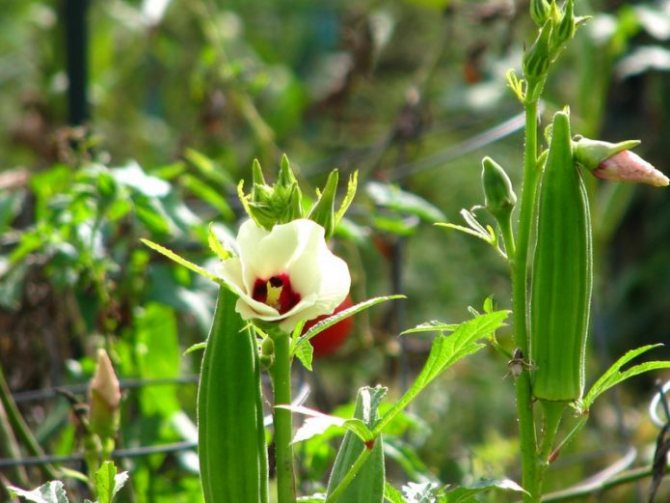

It is very important for okra in our latitudes to grow in a well-lit area.
It is important that the normal development of okra does not literally require tropical heat and humidity. At all stages, from germination to the end of the growing season, it grows quite normally at temperatures of 20-30 degrees. But if recently planted tomatoes, peppers, cucumbers and other thermophilic crops can easily withstand cold snaps up to 15 degrees, and short-term even up to 5 degrees, then for planted okra seedlings everything below 20 degrees is a stop in development, and below 10 degrees - harm , as for other crops, from frost. But an adult strong plant by the end of summer can already tolerate a cold snap, even up to frost.
Despite its tropical origin, okra does not like excessive heat above 40 degrees. This should be taken into account when growing indoors, where at the peak of summer without ventilation, the temperature on a sunny day often rises above this mark.
Okra is an annual plant with a relatively short growing season, only 3-4 months. Therefore, despite the thermophilicity and late dates of planting in open ground, it does not need to be planted as early in February as pepper. The seeds are planted in the ground on March 10–20, and the colder the climate, the later the planting, until the beginning of April.
Transfer to the garden
Okra is planted in open ground very late, in the middle lane on June 10-15. By this time, the earth warms up to a great depth, accumulates heat in a huge massif, and even a short-term drop in air temperature cannot harm thermophilic crops. Due to the late planting dates, okra seedlings are grown in larger containers than other crops. It is not recommended to plant in common boxes, only in separate dishes.
To have enough for development for the entire period before planting, you need a capacity of at least 1 liter per bush. Moreover, the capacity should be high, because the okra has a long central root. When planting, it is important not to damage the taproot.
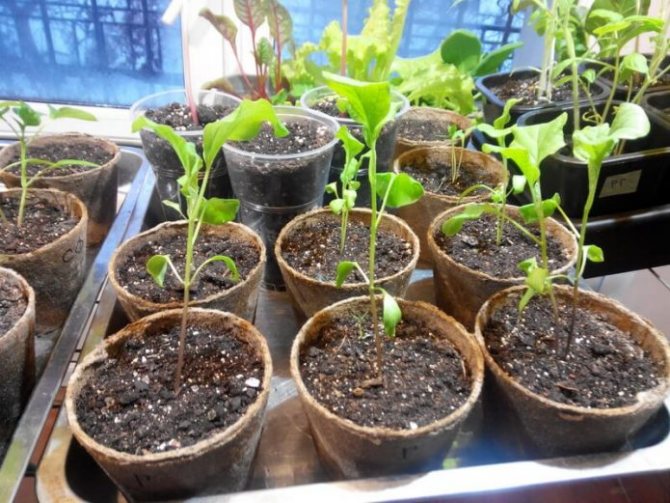

Okra is recommended to be grown in peat pots and planted in the ground in them.
Under a film shelter or in a greenhouse, both day and night temperatures are higher, so okra will grow better indoors. But unlike other crops, it often needs to be ventilated. Excessive moisture can cause gray rot.
When grown on fertile soils, top dressing is not required. In other cases, feeding is required:
- with a weak increase in green mass - with nitrogen fertilizers: watering with a solution of 40 g of urea or ammonium nitrate per 10 liters of water;
- during fruiting - phosphorus fertilizers: nitroammophos or superphosphate, 30 g per 10 liters of water.
The plant is drought-resistant and does not require moisture. On the contrary, in dense, moisture-proof soils, the roots can rot. Therefore, watering is required in dry weather to keep the soil moist for the entire growing period.
Mulching with a layer of up to 10 cm with hay, straw, dry needles, rotten sawdust, humus will greatly facilitate maintenance. Under the mulch, the ground steams, becomes softer and looser, does not dry out, less often requires watering.
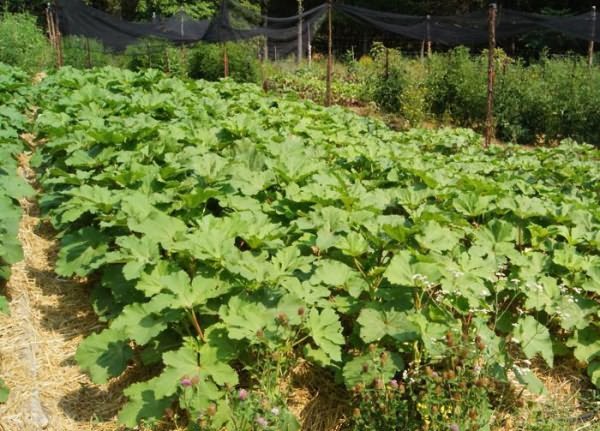

Okra plantations are mulched with straw to protect against weeds
Light mulch reflects sunlight and prevents the earth from warming up. Therefore, light mulch can be spread only on well-heated soil, and dark mulch - at any soil temperature, it will not interfere with solar heating.
In the second half of summer, the central stem must be pinched to stop the growth of the green mass and the formation of a new ovary, which will no longer have time to grow before the cold weather. Then the plant will direct all its forces to growing the already formed ovaries.
The plant can suffer from the same diseases and pests as local crops - powdery mildew, gray rot, thrips, slugs. The measures to combat these misfortunes are the same as for all plants, with the recommended preparations according to the instructions.
Fortunately for many gardeners who decide to grow this plant, Okra is unpretentious in its cultivation and care.
Reproduction methods
There is only 1 way to multiply this culture - collecting seeds, which are later simply sown directly on the ground itself or are grown first, as seedlings. And then, together with the earth, they are transplanted into the greenhouse.
Do not under any circumstances break the roots of the plant, as such okra may not survive and there is a high probability that it will die.
Landing
As mentioned above, okra can be grown in 2 ways:
- Sowing in pre-prepared holes on the land plot.
- Planting seedlings with further transfer of the plant along with the roots to the greenhouse for further cultivation.
It is important to know: it may seem to many that growing this zucchini is a simple matter. But this is not so, since the cultivation of such a plant is a painstaking business, because the okra has not yet fully adapted to our climatic conditions. Remember, okra is a very thermophilic plant and it must be provided with enough light and heat if you want to get a rich harvest.
It is certainly necessary to take care of the plant, but to do it, surprisingly, is quite simple, since the plant is especially undemanding. The main thing is to always dig in the ground under it so that the soil is always slightly moist.
In addition, the plant itself needs to be sufficiently moisturized, but this is rarely recommended (approximately watering the okra is necessary several times a month, no more, because it came to us from warm African countries, which means that it does not tolerate excess moisture very well). Before the first warming, the plant must be slightly fertilized with natural fertilizers.
Powdery mildew
Also remember that okra is quite susceptible to some of its characteristic diseases:
- Powdery mildew.
- All kinds of bacterial diseases (fungus, mold, and so on).
- Aphid.
The above ailments are able to suck out useful trace elements from the plant, which subsequently leads to its complete death. The treatment itself is carried out depending on the type of disease. For example, to combat aphids, it is necessary to remove the insects that produce it (often these are some types of ants), and in the case of mold or fungus, they must be neutralized manually, and then the plant itself must be treated with copper preparations.
It is important to know: it is surprising that the okra is for the most part a thermophilic plant and it is able to bear fruit almost until the first serious (approximately the fruits can be harvested until mid-autumn) onset of frost. Ripening occurs in August and depends on the area where the plant is grown.
Okra is grown in fertile soil. It must be mixed with humus and minerals. Seed planting is carried out to a depth of 4 cm. And after planting, the seeds must be watered, but this must be done very carefully so that a crust does not form on the ground and there is not a large amount of moisture.
The first shoots should appear in two weeks. To do this, you need to provide the seedlings with a temperature regime that is within 15 degrees. If the temperature drops, the seeds will germinate slowly and the seedlings will be weak. This is why it is so important to take proper care of the okra.
Okra and beauty
According to historical data, many ancient beauties (for example, Cleopatra) loved okra very much. They ate dishes from this plant, and also made decoctions and hair masks from it.
In India they cooked
with okra extracts that get rid of acne and prevent their appearance. Therefore, this plant can be used in folk medicine. Funds based on it help to improve the structure of the hair, and therefore will be very useful.
Selection and storage
Young plant pods up to 10 cm long are suitable for food. They should be bright green, not damaged, without mold spots, elastic to the touch. Occasionally you can find pods of dark or reddish colors.
Delicate okra deteriorates very quickly. Stored in the refrigerator for no more than 3 days. In this case, it is worth placing the vegetable in a paper bag. However, okra can be kept in a hermetically sealed container in a dark place for up to three years.
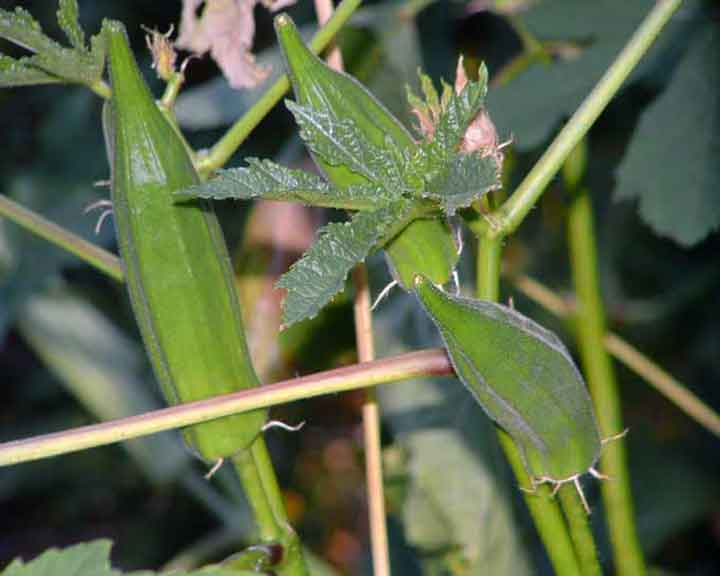

Okra: how to cook?
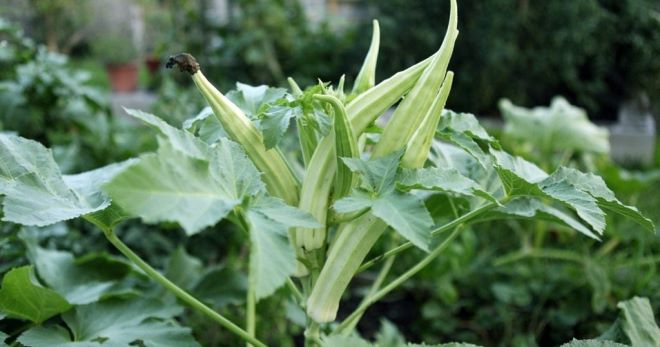

Okra is most commonly used in cooking. It can be fried, stewed and boiled. It tastes somewhat like eggplant and asparagus. Many people use this vegetable in their vegetable salad recipes, and it can also be canned. It is suitable for soups and meat dishes, as well as for snacks and vegetables. As a side dish, this product goes especially well with meat and fish.
When cooked, this vegetable produces a lot of mucus. Therefore, to give it a more piquant taste, simply saute the okra over high heat and add some tomato and lemon juice.
Okra seeds are also noteworthy as they can be prepared instead of coffee. They are also often squeezed to produce oils with a particularly pleasant aroma.
Recipes
Since okra was brought to most European countries in the national cuisine of each of them, there are a couple of dishes prepared with its addition or based on it. Well, let's take a look at the most interesting ones.
Okra with chicken
Okra with chicken
You will need:
- 1 kg okra.
- 1 tbsp. milk.
- 1 kg of medium-sized chicken.
- 0.5 kg of onions.
- 1 kg tomato.
- 1 cup wine vinegar
- 200 grams of olive oil.
- Spices to taste (salt, pepper, basil, paprika and coriander).
Preparation:
First you need to clean the okra thoroughly, and then marinate it in wine vinegar to soften it. Then, we turn to the preparation of the chicken: it must be cleaned of all sorts of excess and marinated in milk (the chicken will acquire a mild creamy smell and taste, and the meat itself will become much more tender). Next, cut the onion into half rings, and make thick tomato paste from the tomatoes. All the ingredients are laid out on top of the okra (first the chicken. Then the onion and pour it all with freshly squeezed tomato juice). It is necessary to bake this dish at a temperature of 200 degrees for an hour.
It's important to know: in order to fully reveal the taste of this dish, it is strictly forbidden to stir it during the cooking process.
Okra in a pot
We all love the seen meat with vegetables in a pot, because this is one of the analogues of a Slavic dish, but with an exotic addition.
You will need:
- Any meat (both chicken and veal are suitable).
- 1 kg of potatoes.
- 1 kg of okra and other vegetables (mushrooms, onions, and so on).
Preparation:
Everything is quite simple: the ingredients are prepared, and then put in a pot and covered with a lid. You need to bake the dish for about an hour at a temperature of 200 degrees.
Main varieties
Depending on the height of the plants, the following varieties are distinguished:
- undersized - bushes 40-50 cm high;
- medium-sized - up to 70 cm;
- tall - up to 2 m.
In the state register of breeding achievements, among those admitted to cultivation on the territory of Russia, there are varieties Juno, Bombay, Vlada.
- Juno. This is a tall variety, up to 2 m, so it is quite productive - 1.7–2.5 kg per square meter. m. Fruits are large, multifaceted, from 10 to 25 cm long, grow very quickly.They are eaten 4-7 days after the ovary is set and as long as they retain their green color. Overripe fruits become tough and lose their taste. It is grown from seeds in seedlings. Recommended to grow indoors.
- Bombay. Low-growing mid-season variety. The period from full germination to the beginning of the economic shelf life is 75 days when grown in the open field. The height of the plant in technical ripeness is 60 cm. The rosette of leaves is raised. Stem and leaves are green, flowers are light yellow. 9-10 fruits (ovaries) about 9 cm long are formed on one plant.
- Vlada. The variety is mid-season, undersized - plant height 40–65 cm. Green stem with sparse hard pubescence. The rosette of leaves is raised, the leaves are dark green in color, the flowers are yellow-cream. One plant forms 18–20 fruits (ovaries) 18–20 cm long.
However, our traveling gardeners bring foreign varieties and try to grow them in their beds.
- Lady fingers. Mid-ripening (period from germination to the beginning of the economic shelf life of 90–115 days) variety for growing in open ground and film greenhouses. Plant up to 1 m high. Fruits in the form of green faceted finger-shaped pods, 6 to 20 cm long.
- White velvet, Green velvet (differ in fruit shades.). Height 30–40 cm. Fruiting is abundant and long - almost until the frost.
- Red velvet. Late grade. Aesthetically valuable: the fruit is red rather than green in color.
- Star of David. Tall variety, short fruits - up to 8 cm.
In any case, if you grow okra in cold regions, you should choose varieties with the shortest growing season of 60 days. They will have time to give a crop in the shortest period of heat.
The fruits of the Juno variety can be consumed as early as 4 days after the ovary The Bombay variety can grow in mid-latitudes and in the open field The Ladies' fingers variety got its name from the shape of the fruit Star of David - one of the most common varieties in Europe Red Velvet has unusual colors
Green velvet
Okra is the main type of okra, which has several subspecies. It is shaped like a long, pointed pod. It is grown for the preparation of various exotic soups:
- Tall green with long pods;
- Tall green with short pods;
- Low green with long pods;
- Low green with short pods;
- Ladies' toes with white pods;
- Ladies' fingers with green pods.
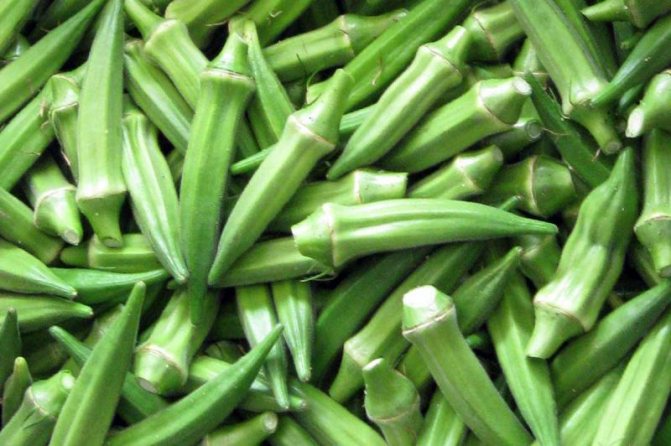

How many new varieties were also artificially grown:
- White cylindrical.
- White velvet.
- Green velvet.
- Dwarf greenery.
- Undisturbed by Clemson.
- Sona.
- Tall.
There are many varieties of okra, different in origin (foreign and local selection), ripening time, fruit size, color, growing conditions. As an example, we give a description of the varieties of okra, the most common in our latitudes:
- Sopilka (mid-ripening). The plant is medium-sized, the stem grows from 100 to 110 cm, its diameter is up to 2.65 cm.The fruit is five-, six-sided, grows in length up to 20 cm.
- Dibrova (mid-season). The variety is undersized, reaches 80 cm in height, the diameter of the stem is 2 cm. The fruit can have 7-9 edges, grows in length up to 21 cm. It is recommended for open ground, its ovary is used for dietary nutrition.
The least whimsical representatives of this vegetable crop, adapted to our growing conditions and soils, are the following varieties:
- White velvet, green velvet - popular for our gardens, more suitable, unlike foreign varieties.
- Red velvet is a late variety, aesthetically valuable, fruiting begins after 70 days
- Blondie - refers to early ripening varieties, promising, resistant to cold
- The Star of David is the most common, tall, short fruits, up to 8 cm.
There are several varieties of this plant.Among them are Ladies' Fingers, White Velvet and White Cylindrical Okra. These varieties are most often grown in our country. It should be noted that this culture is becoming more and more popular among summer residents. This is due to its taste and, of course, beneficial properties. Several new varieties were bred, which can be recommended for cultivation in the conditions of our regions. This is Bombay and Juno.
Harvesting
If you strictly follow the recommendations on crop agrotechnics, the cultivation of okra will end with the collection of a rich harvest. Early ripening okra varieties are covered with flowers at 2 months of age, and 5 days after that, the first bright green pods can be removed from them. In the southern regions of the country, okra is harvested daily. In regions with a temperate climate - every 3-5 days. You can not be late with the collection dates: overripe pods become tough and coarse, they are unsuitable for food.
Okra's stems and leaves are covered with fine bristles that can irritate the skin. Therefore, you need to harvest carefully, trying not to come into contact with the shoots. Cut the pods with a sharp knife. In room conditions, they can lie up to 10 days if placed in a dry cardboard box, having made holes in it for ventilation. It is much more convenient to store fruits in the refrigerator, where they will stay fresh longer. To obtain okra seeds, the pods are left on the plant until fully ripe. Okras bear fruit until autumn, until frost sets in.
Okra is an interesting culture. It has a long history of breeding, and its fruits are widely used in cooking and medicine. Okra pods are used to prepare salads, sauces, side dishes, soups. They can be fried, boiled, dried, pickled, frozen, canned. They even make flour from them. Crushed okra seeds have long been used as a spice, and the drink made from its roasted grains can easily compete with traditional coffee in taste.
Growing this culture on the site will require certain knowledge, but there is nothing complicated about it. Some difficulties are caused by its exotic origin, but they are quite surmountable. It is worth providing the plant with a sufficient amount of heat and light, and it will certainly thank you for its care and attention with an abundance of useful fruits.
Okra: beneficial properties
Okra is often referred to as a vegetarian's dream because it contains a lot of nutrients. This includes protein, iron, vitamins A, K, C, B6, potassium, calcium. In particular, okra is recommended for pregnant women. With its help, a neural tube can form in the first trimester of pregnancy.
This vegetable is able to regulate blood sugar levels. It will also be very useful for people suffering from gastrointestinal diseases. They especially need to eat foods high in okra.
It must be said that this vegetable is great for losing weight, and it does not harm human health. Okra is an excellent aid in reducing asthma attacks. Also, this vegetable will play an excellent role in the dietary nutrition of people who have atherosclerosis.In addition, Abelmos can also strengthen the walls of the capillaries. It will cleanse the body of cholesterol and will also help with constipation or stomach ulcers.
Many studies have been conducted on okra, which have shown that this vegetable helps prevent rectal cancer. He is also able to solve many problems related to potency. Also, this vegetable will help to recover after heavy operations. It can help reduce the risk of cataracts and diabetes.
Like any other product, this plant has its advantages and disadvantages, which, perhaps, should be discussed in detail.
Beneficial features
- Undisturbed Clemson
Since okra has a high content of folic acid and other useful microelements, it is recommended to use it for pregnant and newly minted mothers.
- Diabetics and people with disorders of the gastrointestinal tract are especially recommended to use this zucchini, as it significantly normalizes blood sugar.
- Many do not know, but okra is the best way to lose weight, as it actively burns fat, but at the same time fills the body with the vitamins it needs.
- What could be tastier than coffee? Right! Okra seeds, which can also be brewed after roasting.
Contraindications
As such, there are no contraindications to the use of the plant, but some people may be allergic to it, namely to some areas. But all this is leveled by proper heat treatment. If this is not done, then be prepared for prolonged itching all over the body and slight redness of the skin.
It is also recommended to well peel off small hairs from the skin of the plant, which can also cause an allergic reaction.

